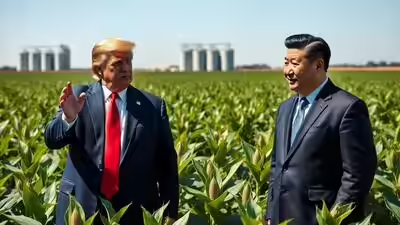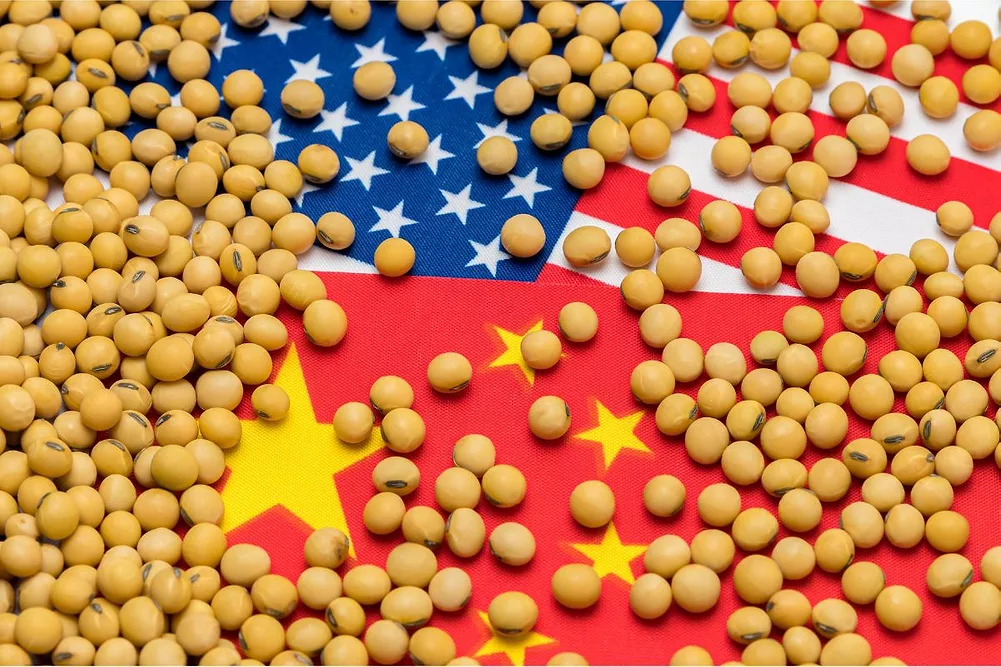While Trump may argue about the long term impacts of his tariffs policies, no argument can be made about its impacts in the short term and its hitting hard. No one felt the true backlash of Trump’s tariffs quicker than soybean farmers. While Washington can afford another trade fight. Farmers can’t. With China pulling back from U.S. soybeans and Brazil stepping in, Trump’s next big deal may decide whether America’s farm belt thrives or fades. This Investocracy article analyzes the core impacts of US tariffs on soybean exports, Moreover it predicts how this stalemate is going to end.
The stakes for the U.S. farm sector could not be higher. In 2024, the United States exported approximately $24.58 billion worth of soybeans, and of that total, roughly $12.84 billion went to China alone. China accounted for more than half of U.S. soybean exports making it not just a top customer, but a dependency. You simply do not mess with a country that is responsible for 7% of your agricultural exports, unless you have a plan. The current US administration unfortunately doesn’t look like it has one, even though they’ve been in this situation before.

Lessons From 2018-19
When the U.S. first imposed tariffs and China retaliated, U.S. agriculture suffered. According to a 2022 United States Department of Agriculture Economic Research Service (ERS) report, annualized export losses in that period reached about $13.2 billion, with soybeans alone accounting for roughly 71% of that total. This time around, export volumes are higher, cost pressures greater so the threat looms even larger. Furthermore, China understands its leverage and is now making bigger threats.
New Form of Retaliation
China’s retaliation was expected to be tariffs on its US imports, and for most products that was the case. However, China threatened that it will not import a single cargo of US soybean, backing Trump into a corner economically and politically with his rural allies. Now imagine a scenario where China stops buying even a single shipment of U.S. soybeans. The immediate export revenue lost would be in the range of $12–13 billion. Beyond that, farmers would face lower prices, rising storage costs, lost market share, and a cascade of consequences across the rural economy. Given this vulnerability, it becomes clear: Donald Trump must urgently pursue a trade deal with China not just for geopolitical headlines, but to secure America’s agricultural backbone.
The Risk Is Already Real
Recent data suggest the worst is already creeping in. From January through August 2025, U.S. soybean exports to China plunged to just 218 million bushels a dramatic drop from prior years when shipments routinely approached a billion bushels. Even though China still imported U.S. soybeans in 2024, analysts warn that no new-crop contracts have been booked, and Brazil has surged into the vacuum.
If China were to cut off U.S. soybeans entirely, the consequences would be severe:
- Farm income hit: With half of exports disappearing overnight, farmers would face steep revenue losses.
- Price collapse: A large surplus would push U.S. soybean prices down, further eroding income.
- Market share lost for good: China has already shifted toward suppliers in South America; regaining those buyers would be costly and slow.
- State economy damage: Major soybean-producing states like Iowa, Illinois and Minnesota would feel the hits in billions of dollars — affecting everything from inputs to rural services.
- Supply chain disruption: Crushing capacity, transportation, storage and export logistics would all feel the strain.
International Competition
According to the International Trade Centre (ITC), in 2015, before the first term of President Trump, China imported approximately 34 billion USD worth of soybeans. The US’s share was 12.4 billion, second only to Brazil whose share was approximately 16.9 billion. Jump ahead to 2024, the US’s soybean exports to China dropped to approximately 12 billion USD; while Brazil’s soybean exports to China accelerated to reach 36.5 billion USD. In the same period, China was consistently the largest importer of US soybeans, always purchasing more than 50% of US soybeans exports except in 2018. These figures reflect China’s success and US’ failure to diversify their trade partners when it comes to soybean and shifting dependence away from each other, when it comes to soybeans trade the US simply needs China more.
Why a Deal Makes Strategic Sense for Trump
From a political and economic standpoint, a trade deal with China centered on soybeans presents a win-win for the Trump administration:
- Protecting rural allies: Many of Trump’s key constituency voters are in farm country. A deal would boost his standing among this demographic.
- Economic dividends: A restored Chinese market means billions in revenue flowing through U.S. agriculture, sustaining jobs, tax bases and rural investment.
- Global leadership signal: Demonstrating that the U.S. can negotiate effectively enhances America’s credibility in trade matters beyond just agriculture.
- Leverage for other priorities: Soybeans could serve as a strategic bridge to broader discussions on tech, currency and China’s domestic reforms.
What Should the Deal Include?
A meaningful China-U.S. soybean deal should address several core elements:
- Tariff rollback: Lower or eliminate the tariffs and duties that made U.S. soybeans non-competitive in China.
- Advance contracts: China should commit to forward-year purchase contracts, giving U.S. producers certainty and planning visibility.
- Market access guarantees: Ensure inspection, licensing and phytosanitary regimes don’t become stealth barriers. Recent license suspensions of U.S. firms by China show how fragile access can be.
- Public-private coordination: U.S. and Chinese governments should coordinate supply chain logistics, seed variety differentiation, and traceability protocols to facilitate bilateral trade.
- Contingency buffer: Recognising the permanent market-share loss to Brazil and Argentina, include mechanisms (subsidies, restructuring funds) to aid U.S. farmers while the market rebuilds.
Why Time Is of the Essence
Delaying a deal risks more than just lost revenue. It risks structural replacement. Brazil now supplies China at scale, with lower costs and favorable infrastructure. If the U.S. doesn’t act, soybeans may become a non-factor in China’s feed-stock strategy and the damage to U.S. farmer livelihoods could become permanent. To quote one industry voice: “Our export market to China has just been decimated while competitors step in.”
Additionally, the domestic farm economy is under pressure. Input costs (fertiliser, fuel, seed) are elevated; credit margins are tight. A loss in export income hits at a vulnerable moment. Add to that weaker global soybean price outlooks and shrinking buffers, and the scenario becomes dangerous.
Why Is Trump’s Risk a Counter-Risk?
Some argue that Trump’s tougher stance on China is a show of strength. But the backlash through agriculture is precisely why a deal makes sense. Without one, he risks alienating the very base that delivered his earlier wins: the farmers and rural voters. A deal reassures them that his tough policy hasn’t forgotten their bottom line. Moreover, the global agricultural market is evolving. China’s supply chain is increasingly diversified. Waiting to reconvene negotiations means letting U.S. share shrink further. The strategic “right moment” is now.
Deal Imminent?
The clock is ticking and time is running out on the US president. Despite the figures that show an asymmetrical trade relationship between both countries, the US administration showed strength (at least on the outside) at the beginning of negotiations. However, additional pressures now apply that further weakens the US’s stance in this deal. We’ve reached the harvesting season and while soybeans can be stored up to a year, the farmers need to get their money so they can start preparing for the new season of planting, there is also a risk of some of the harvest ruining if it’s exposed to moisture as winter approaches. Furthermore, farmers can hardly depend on the government bailing them out amid government shutdown over an already inflated spending bill.
How Is It Going to End?
There’s only one winner here, and it’s not the mighty United States of America. All of the factors mentioned in this article show why the US needs to make the deal now! A meeting between Trump and China’s Xi Jinping has already been announced, the soybeans issue will definitely be on the table. Furthermore, China has already shown good will with the TikTok deal. A deal is expected to be announced later next week after the meeting between both presidents and agreement on a trade framework
Conclusion
In crop fields across America from Iowa’s rolling plains to Illinois’ productive acreage to Minnesota’s bean belt the impact of a lost Chinese market is not a distant risk. It’s real and growing. Every dollar of soybeans not shipped is income not earned, machinery not upgraded, banks not paid, and rural communities left with fewer resources.
If President Trump wants to safeguard U.S. agriculture, bolster rural economies, and reinforce his commercial credibility, he must prioritize a deal with China over soybeans. The farm belt is waiting. The global pivot to Brazil is underway. The time to act is now.



